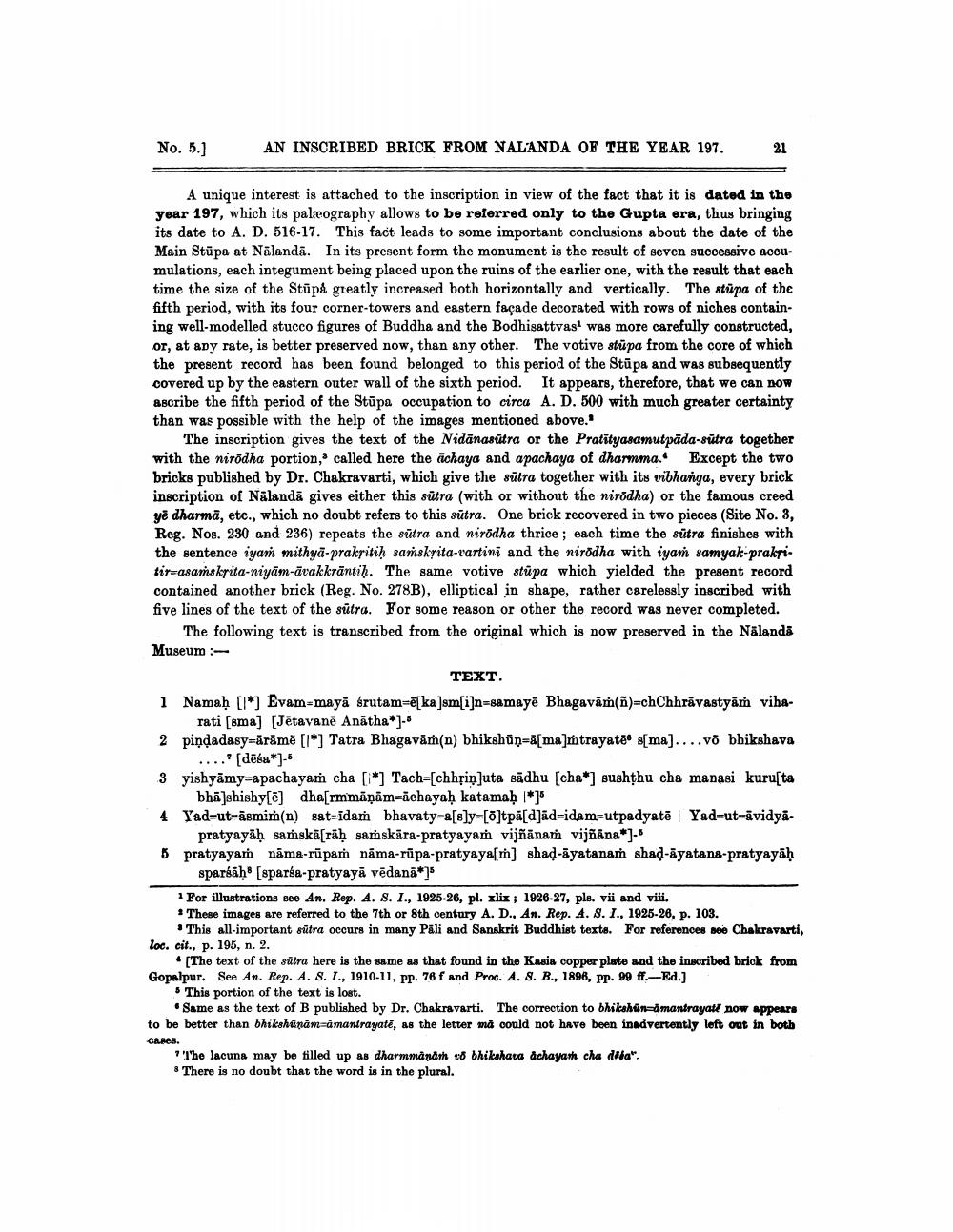________________
No. 5.]
AN INSCRIBED BRICK FROM NALANDA OF THE YEAR 197.
A unique interest is attached to the inscription in view of the fact that it is dated in the year 197, which its palæography allows to be referred only to the Gupta era, thus bringing its date to A. D. 516-17. This fact leads to some important conclusions about the date of the Main Stupa at Nālandā. In its present form the monument is the result of seven successive accumulations, each integument being placed upon the ruins of the earlier one, with the result that each time the size of the Stupå greatly increased both horizontally and vertically. The stupa of the fifth period, with its four corner-towers and eastern façade decorated with rows of niches containing well-modelled stucco figures of Buddha and the Bodhisattvas1 was more carefully constructed, or, at any rate, is better preserved now, than any other. The votive stupa from the core of which the present record has been found belonged to this period of the Stupa and was subsequently covered up by the eastern outer wall of the sixth period. It appears, therefore, that we can now ascribe the fifth period of the Stupa occupation to circa A. D. 500 with much greater certainty than was possible with the help of the images mentioned above."
The inscription gives the text of the Nidanasutra or the Pratityasamutpada-sutra together with the nirodha portion, called here the achaya and apachaya of dharmma. Except the two bricks published by Dr. Chakravarti, which give the sutra together with its vibhanga, every brick inscription of Nalanda gives either this sutra (with or without the nirodha) or the famous creed ye dharma, etc., which no doubt refers to this sutra. One brick recovered in two pieces (Site No. 3, Reg. Nos. 230 and 236) repeats the sutra and nirodha thrice; each time the sutra finishes with the sentence iyam mithya-prakritiḥ samskrita-vartini and the nirodha with iyam samyak-prakri tir-asamskrita-niyām-āvakkrāntiḥ. The same votive stupa which yielded the present record contained another brick (Reg. No. 278B), elliptical in shape, rather carelessly inscribed with five lines of the text of the sutra. For some reason or other the record was never completed. The following text is transcribed from the original which is now preserved in the Nālandā Museum :
TEXT.
21
1 Namaḥ [*] Evam-maya śrutam-e[ka]sm[i]n-samayë Bhagavāṁ(ñ)-chChhrāvastyām viharati [sma] [Jētavane Anatha*]-5
2 pindadasy-ārāme [*] Tatra Bhagavāṁ(n) bhikshūņ=ā[ma]mtrayatē s[ma]....vō bhikshava ...." [dēśa*]-5
3 yishyamy-apachayam cha [*] Tach-[chhṛin]uta sadhu [cha*] sushthu cha manasi kuru[ta bhashishy[e] dha[rmmāṇām-āchayah katamaḥ *
4 Yad-ut-asmim(n) sat-īdam bhavaty=a[s]y=[ö]tpa[d]ād=idam-utpadyatē | Yad-ut-avidyapratyayaḥ samska[rāḥ saṁskāra-pratyayaṁ vijñānam vijñāna*]
5 pratyayam nama-rupaṁ nama-rupa-pratyaya[m] shaḍ-ayatanam shad-ayatana-pratyayāḥ sparkah [sparia-pratyayā vēdanā**
1 For illustrations see An. Rep. A. S. I., 1925-26, pl. xlix; 1926-27, pls. vii and viii.
* These images are referred to the 7th or 8th century A. D., An. Rep. A. 8. I., 1925-26, p. 103.
This all-important sutra occurs in many Pali and Sanskrit Buddhist texts. For references see Chakravarti, loc. cit., p. 195, n. 2.
[The text of the sutra here is the same as that found in the Kasia copper plate and the inscribed brick from Gopalpur. See An. Rep. A. S. I., 1910-11, pp. 76 f and Proc. A. S. B., 1896, pp. 99 ff.-Ed.]
5 This portion of the text is lost.
Same as the text of B published by Dr. Chakravarti. The correction to bhikshun-amantrayatë now appears to be better than bhikshūņām-āmantrayate, as the letter mă could not have been inadvertently left out in both
cases.
''The lacuna may be filled up as dharmmāṇām vō bhikshava achayam cha diba". There is no doubt that the word is in the plural.




